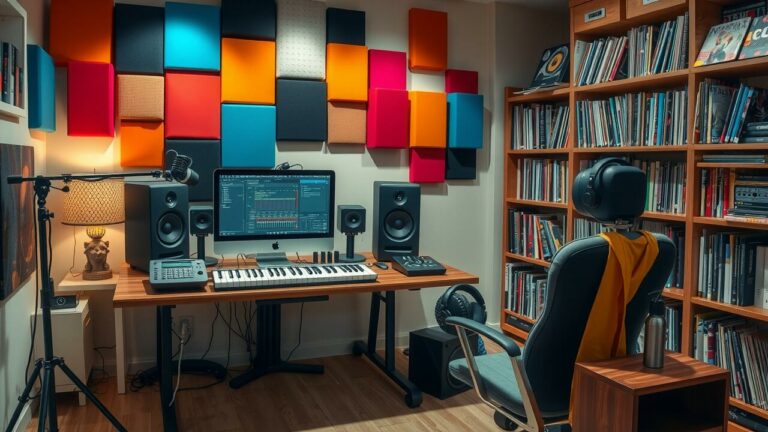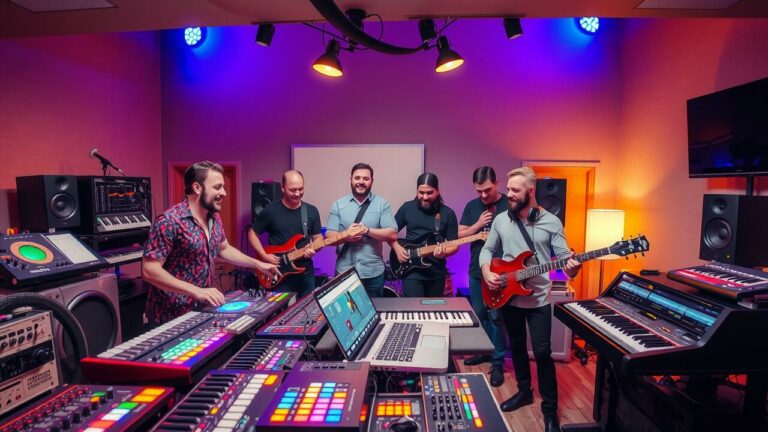Mix Like a Pro: 10 Audio Mixing Techniques for Clean, Crisp Tracks
The Power of Automation in Mixing
Automation emerges as a formidable ally in the realm of audio mixing, granting sound engineers an exquisite level of control over myriad parameters that evolve with time. By deftly automating volume levels, panning positions, and effects settings, you conjure movement and depth within your mix—an intricate dance that not only amplifies the listening experience but also ensures every element retains its distinct voice throughout the track’s journey. Those subtle tweaks? They can metamorphose a static sound into a vibrant performance that grips the listener’s attention like never before.
Embracing automation doesn’t just enhance creativity; it streamlines the whole mixing process. By designating specific points for changes, you liberate yourself from the relentless cycle of manual adjustments—opening up precious time for daring experimentation! This dynamic capability allows mixers to spotlight particular sections of a track or elevate certain instruments to prominence while crafting airy spaces in less frenetic passages. Ultimately, wielding automation with finesse transforms an ordinary mix into something extraordinary—a polished gem that captivates and engages its audience on multiple levels.
Creating Dynamic Changes Throughout Your Track
Dynamic shifts throughout a track are absolutely vital for snaring listener interest and amplifying emotional resonance. Now, here’s where automation techniques come into play! They can be a game-changer, enabling meticulous tweaks in volume, panning, and effects as time ticks on. Those subtle nudges? They conjure up a sense of movement that keeps the ears perked up. And those more dramatic swings? Ah, they act like spotlight moments that pull focus to the pivotal elements of your composition. Transitioning between sections with varying dynamics crafts a narrative arc—an invitation for listeners to dive deeper into the music’s unfolding story.
Let’s not overlook crescendos and decrescendos; these are essential ingredients that add layers to your mix. The gradual build-up and tapering off of intensity can heighten tension or provide sweet release, enriching the auditory feast presented before you! Plus, there’s something almost magical about employing silence strategically—it packs quite a punch! A well-placed pause can amplify the impact of what follows, making every note resonate even more profoundly within the overall dynamic spectrum. When changes are thoughtfully woven together, they create an immersive sonic journey—one that beckons your audience to stay enchanted from beginning to end!
| Dynamic Element | Description | Effect on Listener |
|---|---|---|
| Crescendos | A gradual increase in volume and intensity | Heightens emotional tension, creates anticipation |
| Decrescendos | A gradual decrease in volume and intensity | Provides a sense of release, calms the listener |
| Automation | Use of technology to make precise changes over time | Enhances movement and focus within the track |
| Silence | Strategic pauses within the music | Amplifies the impact of subsequent notes or sections |
| Dynamic Panning | Shifts the placement of sound within the stereo field | Creates a sense of space and movement, engages listeners |
Layering Sounds for Richer Textures
Melding various sounds into a cohesive whole can truly transform the essence of a track. This artful endeavor opens gateways to intricate sonic realms that not only captivate listeners but also envelop them in an all-consuming experience. As you layer, it’s crucial—oh so crucial—to pay heed to the unique traits each sound brings to the table. You want these elements dancing together, harmonizing rather than clashing like dueling egos at a party.
Dare to dive into experimentation with an array of sound types, and watch as it elevates texture beyond mere surface level. Picture this: weaving melodic instruments through ethereal ambient pads creates a lush tapestry of sound that feels almost tangible. Now sprinkle in some percussive accents on top, injecting rhythm and momentum that propels the listener forward! Each layer? It needs to have its own mission—be it deepening the overall vibe or amplifying emotional resonance within your composition.
And let’s not forget about balance; tweaking levels and fine-tuning EQ settings are essential steps toward crafting that polished gem—a final product that’s both engaging and sonically satisfying!
Best Practices for Combining Multiple Instruments
Crafting a mix that harmoniously weaves together multiple instruments isn’t just an art—it’s a delicate dance of clarity and balance. First, you’ll want to handpick sounds that complement each other beautifully, enhancing the overall tapestry instead of clashing in dissonance. Keep your ears tuned to their frequency ranges; think of it as giving each instrument its own cozy nook within the sonic landscape. Employing equalization is key here—it’s like sculpting out distinct niches in the frequency spectrum. Take, for instance, the bass guitar and kick drum: if they both inhabit those low-end frequencies, a few subtle tweaks on either can work wonders to eliminate any muddiness.
Now let’s talk about panning—a vital technique that breathes space and depth into your mix! Spreading instruments across the stereo field not only fosters separation but also sidesteps cluttered chaos. Sure, traditional instruments can slide left or right with ease, but don’t forget about digital ones—they too thrive when placed creatively! Strive for that balanced soundstage where no section feels cramped or overwhelmed by others. Dive into different panning positions; you might stumble upon fresh dimensions in your mix that ignite an exhilarating listening experience!
- Focus on selecting instrument pairings that enhance each other’s strengths.
- Maintain a balanced frequency range to ensure clarity in the mix.
- Use equalization wisely to carve out space for each instrument.
- Experiment with different panning positions to create a dynamic stereo image.
- Regularly listen back to your mix in various environments to evaluate its balance.
- Don’t hesitate to adjust levels continuously as your mix evolves.
- Trust your ears; if something feels off, be willing to make changes for a better blend.
Using Reference Tracks for Quality Control
Incorporating reference tracks into your mixing journey? Oh, what a treasure trove of insight! Think of it as a guiding star amid the vast cosmos of sound. When you select tunes that resonate with the sonic essence of your creation—bam! You’ve got yourself a benchmark to measure against. This practice isn’t just about listening; it’s about dissecting where your mix might be veering off course, lacking that crisp clarity or balanced ebb and flow.
Now, let’s dive deeper—analysis is key here! Tune in closely to how elements like vocal placement dance within the mix, how instruments weave their stories apart yet together, and how frequency balance crafts an overall tapestry of sound. It’s in comparing your work with those high-caliber professional tracks where revelations unfold—strengths emerge while weaknesses lurking in shadows become glaringly obvious. This newfound awareness can spark revisions that steer you towards a more polished outcome, one that shimmers with professionalism.
Utilizing reference tracks doesn’t merely streamline the arduous mixing process; no! It fortifies your confidence too—a crucial ingredient for conjuring up sounds that not only compete but also captivate. So go ahead, embrace this method and watch as your craft transforms before your very ears!
Analyzing Professional Mixes for Improvement
Diving into the intricate tapestry of professional mixes can unlock a treasure trove of insights for your own sonic endeavors. Begin by handpicking a selection of tracks that resonate with the sound you yearn to capture, those shimmering gems that embody your aspirations. Engage in a deep listen—no mere casual background noise here! Pay close attention to how each element dances within the mix, savoring the delicate balance and the clever use of space, while untangling the web of frequency distribution.
Notice how every instrument finds its cozy nook amid the chaos; observe how effects are deftly wielded to elevate clarity and depth as if sculpting sound from marble. Pinpointing these nuances is key—it’s like finding hidden pathways through an intricate maze that can refine your mixing technique.
Moreover, don’t shy away from employing tools such as spectrum analyzers and metering software—they’re like having a magnifying glass for dissecting the technical intricacies embedded in your reference tracks. Scrutinize EQ curves, dynamic ranges, and stereo widths—each element revealing secrets about what makes professional mixes tick. By juxtaposing these characteristics against your own creations, you’ll shine light on any areas needing attention—a roadmap guiding you toward growth and enhancement. This analytical journey isn’t just about tweaking knobs; it’s about cultivating skills that propel you closer to that coveted polished finish!
Managing Loudness Levels
Striking the perfect balance in loudness levels is paramount for crafting tracks that not only stand tall in a crowded audio landscape but also resonate seamlessly across an array of playback systems. Picture this: a deft blend of mixing techniques coupled with powerful tools—compression, limiting, and meticulous gain staging—all working in concert to ensure your sound retains its clarity while soaring to the desired peaks of loudness. It’s all about those fine-tuned adjustments; engineers artfully navigate these elements to safeguard the dynamic range of their mixes while shining a spotlight on critical components like vocals or lead instruments.
Now, here’s where it gets interesting: keeping an ear on your mix at various playback levels can unveil hidden flaws begging for attention. Enter metering tools! These nifty gadgets analyze loudness through LUFS (Loudness Units relative to Full Scale), offering you a reliable benchmark that steers your mixing choices. By aiming for industry standards in loudness, you sidestep pitfalls like distortion and clipping—ultimately sculpting a cleaner, more polished final product that resonates deeply with audiences across diverse platforms.
Techniques to Achieve a Competitive Mix
Crafting that elusive competitive mix demands an intricate dance with loudness levels across every sonic layer of your track. Begin by assigning each instrument its unique role, while ensuring it harmonizes beautifully within the grand tapestry of sound. Lean on tools like compression and limiting to tame dynamics—but tread lightly! Over-processing can lead you astray. A well-cultivated dynamic range not only sharpens clarity but also delivers a punchy listening experience that resonates.
Vigilantly monitor your mix at varying volume levels; this practice reveals how the overall balance behaves in diverse auditory environments—a crucial step often overlooked.
Equipping yourself with a high-quality monitoring setup is non-negotiable if you seek to make judicious mixing decisions. Splash out on solid studio monitors and consider coupling them with reference headphones for that extra pinch of insight. Dive deep into analysis, pitting your mix against professional tracks within your genre—zero in on frequency distribution, spatial depth, and all those subtle nuances. This reflective comparison unveils strengths and weaknesses alike, illuminating the path for pivotal adjustments.
Don’t underestimate metering tools—they’re your allies in gauging levels accurately, helping ensure your track cuts through the noise of contemporary releases without sacrificing an ounce of quality!
Finalizing Your Mix
The final phase of the mixing process—oh, it’s nothing short of crucial! It’s that pivotal moment when your track must truly shine amid a sea of competition. Here, mastering techniques come into play like skilled artisans shaping raw clay, honing in on that perfect sound, primed for distribution. A masterfully crafted track strikes an exquisite balance across frequencies; it radiates clarity and presence with every note.
Now, let’s talk tools—equalization dances with compression while limiting holds everything together like a steadfast guardian. Each tweak demands precision and thoughtfulness; you can’t just slap things around haphazardly! You’ve got to consider the genre’s essence and where listeners will immerse themselves in your auditory creation.
Then comes the nitty-gritty of preparing your masterpiece for playback—a multifaceted endeavor! You simply cannot overlook how the mix translates on various systems: headphones whispering secrets to your ears, car stereos pumping out beats as you cruise along boulevards, or streaming platforms broadcasting your genius far and wide. By immersing yourself in diverse listening environments, you’ll catch those pesky issues lurking just beyond what’s evident in your primary monitoring setup.
And don’t forget about formats—generating high-resolution files for digital distribution is paramount if you want to preserve quality across all platforms! Finally, evaluate against similar tracks; they can be illuminating guides leading you toward those final tweaks before unleashing your work upon an eager world.
Preparing Your Track for Distribution and Playback
Nailing your track’s mastering—ah, the grand finale before it dances into the world of distribution! It’s all about meticulously sculpting that sound, honing every nuance to achieve impeccable consistency and quality. Picture yourself adjusting levels like a skilled painter wielding a brush, tweaking equalization to carve out clarity, manipulating dynamics for emotional punch, and stretching stereo width until that sonic landscape feels expansive. The goal? Crafting something polished enough to shine!
Take moments—yes, precious moments—to pit your creation against industry titans; cue up those reference tracks that exemplify professional mixes at their zenith. This isn’t just casual listening; it’s an expedition through sound, revealing areas where your masterpiece might still be rough around the edges or in need of a sprinkle of magic dust.
And then comes the next chapter: preparing for distribution—a crucial step indeed! Your audio files must don their finest attire; think WAV or AIFF for pristine delivery. Don’t overlook metadata—it’s like putting on a name tag for parties where everyone wants to know who you are! Title? Check. Artist name? Absolutely. Genre? You betcha! This info is essential for streaming platforms and digital storefronts alike.
But wait—there’s more! Consider those pesky loudness normalization standards demanded by various platforms so your track retains its integrity across diverse playback systems. Trust me—the right prep can elevate the listener’s experience from mundane to magnificent, ensuring your music struts onto the stage in nothing less than its best possible light!
Conclusion
Mastering the intricate craft of audio mixing is a delightful dance—a fusion of creativity, technical prowess, and a keen grasp of an array of techniques. Dive into the strategies we’ve explored: automation that breathes life into your sound, layering that weaves textures together like threads in a tapestry, and reference tracks that guide you toward clarity. These elements can elevate your music into realms where clarity and impact reign supreme.
Paying attention to loudness levels? Absolutely essential! Refining every nuance in your mix is not just advisable; it’s crucial for standing tall amidst today’s fiercely competitive sonic landscape.
In essence, mixing is about striking that elusive balance—one that honors the artist’s vision while simultaneously resonating with listeners on an emotional frequency. It demands continuous practice paired with an eager eye for self-analysis, both key ingredients for transforming your skills over time. By embracing these multifaceted techniques, you’ll cultivate tracks that shimmer—clean, crisp, polished productions destined to captivate both yourself and your audience alike!
FAQS
What’s the significance of automation in mixing?
Ah, automation—it’s like the magic wand of music production! It breathes life into your track, creating dynamic shifts that captivate listeners. By meticulously adjusting levels, effects, and panning over time, you craft an auditory journey that keeps ears perked and hearts racing.
How can I layer sounds effectively to create richer textures?
Layering sounds is both an art and a science! Start by selecting instruments that complement each other harmonically; think of them as puzzle pieces fitting together. Then, wield EQ with finesse to carve out sonic real estate for every layer within the mix—this ensures each element shines without clashing!
What are reference tracks and how do I use them?
Reference tracks—the gold standard in your mixing toolkit! These are professionally crafted songs that resonate with you. They act as guiding stars for your own mix’s quality. Dive deep into their balance, frequency distribution, and loudness to glean insights that elevate your work from good to extraordinary.
What techniques can I use to manage loudness levels in my mix?
Managing loudness is crucial—and it requires a delicate touch! Equip yourself with metering tools; they’re your eyes in this audio landscape. Use compression wisely—think surgical precision rather than brute force—to sculpt dynamics while ensuring all elements play nicely together for a polished yet powerful sound.
What steps should I follow for finalizing my mix before distribution?
The grand finale of mixing calls for mastering mastery! First up, adjust those overall levels until everything sings in harmony. Next, apply EQ strategically to bolster clarity across frequencies. Finally—and oh so importantly—test how your track translates on various playback systems; this step ensures it resonates everywhere from earbuds to stadiums!





